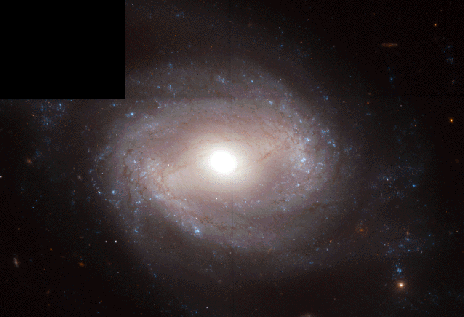
|
Explanation: In this century, the discovery that the Universe is expanding has produced a revolution in human thought about the Cosmos. American astronomer Edwin Hubble played a major role in this profound discovery, coining the "Hubble constant". This single number describes the rate of the cosmic expansion, relating the apparent recession velocities of external galaxies to their distance. Two groups of astronomers trying to measure this fundamental constant using the Hubble Space Telescope (HST) are continuing to report conflicting results. One group, led by astronomer Allan Sandage, measures distances to galaxies using pulsating Cepheid variable stars and supernovae observed in galaxies like the Virgo Cluster spiral galaxy, NGC4639, shown above. This galaxy is the most distant one to which Cepheid-based determinations have been made and was also the site of a well-studied 1990 supernova. Their results favor a relatively small Hubble constant (slow expansion rate) of about 55 kilometers per second per megaparsec which means that galaxies one megaparsec (3 million lightyears) distant appear to recede from us at a speed of 55 kilometers per second. A substantially faster expansion rate (larger Hubble constant) is being reported by astronomer Wendy Freedman and collaborators, also based on HST data. The value of Hubble's constant was recently the subject of a popular public debate titled "The Scale of the Universe 1996: The Value of Hubble's Constant".
|
January February March April May June July August September October November December |
| ||||||||||||||||||||||||||||||||||||||||||||||||
NASA Web Site Statements, Warnings, and Disclaimers
NASA Official: Jay Norris. Specific rights apply.
A service of: LHEA at NASA / GSFC
& Michigan Tech. U.
Based on Astronomy Picture
Of the Day
Publications with keywords: universe - HST
Publications with words: universe - HST
See also:
